#Practical Applications
Explore tagged Tumblr posts
Text
Putting out fire using Bernoulli's principle.
319 notes
·
View notes
Text
"Can you believe it? They 'ad it in their hands. They could've built a working steam engine, and steamboats that didn't explode. That's academics for you. All that knowing and they went back to discussing t'beauty and truth of numbers and missed the fact that they'd discovered something important. Me? If I want beauty and truth I look at Iron Girder."
Terry Pratchett, Raising Steam
#dick simnel#iron girder#raising steam#discworld#terry pratchett#academics#philosophers#theoretical#research#knowledge#wisdom#engineers#practical applications#steam power#truth#beauty#perspective#priorities#can you believe it#something important
82 notes
·
View notes
Text
Two things to add:
Yes, absolutely this. 100% in spirit. And add to this that chances are the math in some of those studies is bullshit, even apart from the fact that the study is being applied to things it has nothing to do with. The more studies in the chain/group, the higher the chance is that one of them is done badly/wrongly, and then your whole house of cards breaks completely anyways (because it doesn't matter how great and osha-compliant every other level of your tower is: if one of them is made of paper mache, then the whole thing will fall. logic works the same way).
The one thing I can't sign is "And any one of these steps individually would be fine and totally unavoidable" Because no, they are not. If every single one of them were then the result would actually be fine. The problem with the 'steps' ist that all of them have something wrong with them: very specific circumstances/constraints, certain errors they are introducing, bc that 'step' only 'works kinda', etc, etc. And those things add up; worse: they're multiplicative. You end up in summary with a result that applies to spherical apple trees in a vacuum that are simultaneously on swiss and american soil, and the chance that even then the result is wrong (*) is, if you're very lucky, 95%, and otherwise 99.99999998%.
(*) this does not mean that the opposite is true, but that you cannot say anything either way
data about where carbon emissions are coming from is so frustrating cause there's all kinds of huge, sprawling, just fucking vast breakdowns of What Causes The Most Carbon Emissions Out Of All Everything In The Entire World, but those are aggregations of numerous smaller but still vast aggregations of data, which are processed and polished from various aggregations of crunched numbers, which are patched and pieced together from various studies, estimates and calculations, which are sieved out of numbers crunched from various measurements, estimates and records, which have been collected, estimated or otherwise conceived through an unspeakably huge variety of methodologies with unspeakably huge variety in limitations, reliability and margins of error.
Even if some of the data was very fine-grained at the beginning, it was filtered through some very coarse number-crunching techniques for the sake of the coarse data, so the results are only as good as the wrongest thing you did in any part of this process, but the plans of action are getting thought up from the top down, which makes the whole thing a hot fucking mess.
For example. And I just made this example up. Say you want to know whether apples or potatoes have a worse impact on climate change. So you look at one of these huge ass infographic things. And it says that potatoes are bad, whereas apples are REALLY good, the BEST crop actually. So it's better to eat apples than potatoes, you think to yourself. Actually we should find a way to replace potatoes with apples! We should fund genetic engineering of apples so they have more starch and can replace potatoes. Great idea. Time to get some investors to put $5 billion towards it.
But actually. Where'd they get that conclusion about apples? Well there's this review right here of the carbon footprint of all different fruits, seems legit. Where'd that data come from? Well it's citing this study right here saying that tree-grown crops are better because they sequester carbon, and this study right here about the distance that different fruits get transported, and this study right here where different fertilization systems are compared in terms of their carbon footprint, and this study over here that sampled 300 apple, peach, and orange farmers comparing their irrigation practices and rates of tree mortality, and this study...wow, okay, seems really reliable...
...what's the first study citing? oh, okay, here's a study about mycorrhizal networks in orchards in Oregon, saying that there's a super high density of fungal mycelium in the 16 orchards that they sampled. And here's a study about leaf litter decay rates in Switzerland under different pesticide regimes, and...okay...relationship of tree spacing to below ground vs. aboveground biomass...a review of above and below-ground biomass in semi-intensively managed orchard plots...
...That one cites "Relationship between biomass and CO2 requirements...carbon immobilization in soil of various tree species...mycorrhizal fungi impact on carbon storage...
...wait a second, none of these are talking about apples, they're about boreal forests...and orange trees...and peanut farms! They're just speculating on roughly applying the non-apple data to apples. You have to go backwards...
Yes! "A review of belowground carbon storage in orchard cropping systems!" Seems like overall the studies find potentially high carbon storage in orchard environments! Walnuts...pears...oranges... intercropping walnuts and wheat... intercropping apples and wheat... wait a second, what about orchards with only apples?
Time for you to go back again...
"New method of mulching in apple orchards can lower irrigation and pesticide needs..." okay but if it's new, most farmers aren't doing it. "Orchards with high density interplanted with annual crops show way more mycorrhizal fungus activity..." "Mycorrhizal associations with trees in the genus Malus..."
...And pretty soon you've spent Five Fucking Hours investigating apples and you've got yourself in this tangled web of citations that demonstrate that some orchard crops (not necessarily apples) store a lot of long-lasting biomass in their trunks and roots really well—and some apple orchards (not necessarily typical ones) have high amounts of mycorrhizal fungi—and some techniques of mulching in orchards (not necessarily the ones apple farmers use) experience less erosion—and some apple trees (not necessarily productive agricultural apples) have really deep root systems—
—and some environments with trees, compared with some conventional agricultural fields, store more carbon and experience less erosion, but not apple orchards because that data wasn't collected in apple orchards.
And you figure out eventually that there is no direct evidence anywhere in the inputs that singles out apples as The Best Crop For Fighting Climate Change, or suggests that conventional apple farming has a much smaller carbon footprint than anything else.
The data just spit out "apples" after an unholy writhing mass of Processes that involved 1) observing some tree-grown crops and deciding it applies closely enough to all tree grown crops 2) observing some apple orchards and deciding its applicable enough to all apple orchards 3) observing some tree-including environments and deciding its close enough to all tree-including environments 4) observing some farming methods and deciding it applies closely enough to all farming methods
And any one of these steps individually would be fine and totally unavoidable, but when strung together repeatedly they distort the original data into A Puddle of Goo.
And it wouldn't be that bad even to string them together, if trees didn't vary that much, and farming didn't vary that much, and soil didn't vary that much, and mycorrhizal networks didn't vary that much, and regions that grow apples didn't vary that much, and pre-conversion-to-apple-orchard states of apple orchards didn't vary that much, and economic incentives controlling apple farming didn't vary that much, but all of these things DO vary, a Fuck Ton, and if the full range of variation were taken into account—nay, intentionally optimized—the distinction between apples and potatoes might turn out to be be MEANINGLESS GOO.
anyway big size piles of data about Farming, In General, make me so bitchy
2K notes
·
View notes
Text
This demonstration by the Easton group that work output can be harnessed and quantified in such molecular machines takes researchers one step closer to the practical application of nanotechnology.
"Chemistry" 2e - Blackman, A., Bottle, S., Schmid, S., Mocerino, M., Wille, U.
#book quote#chemistry#nonfiction#textbook#demonstration#chris easton#work output#molecular machine#researchers#practical applications#nanotechnology
0 notes
Text
Learn about perception and how to change it for the better
#how to alter your perception#personal growth#How to Altered Your Perception for the Better#perception psychology#negative thinking#SelfImprovement#MindsetShift#PositiveThinking#PersonalGrowth#ChangeYourMindset#PerceptionShift#PositiveChange#Mindfulness#SelfDevelopment#thoughts and behaviors#the elite power of perception#kaleidoscope#practical applications#thoughts and feelings#personal growth challenge#personal growth company#positive change podcast#self improvement.esp
0 notes
Text
Guidance for choose right topic for Your MBA course Based on Specialization
Choosing the right topic for your MBA course is a pivotal decision that can significantly impact your academic journey and future career prospects.
The first step is to identify your MBA specialization, whether it's in Finance, Marketing, Operations, Human Resources, or Entrepreneurship. Understanding the nuances of each specialization is crucial to tailoring your research focus.
As you delve into the selection process, take time for self-reflection. Consider your personal interests, career aspirations, and the specific skills you aim to develop through your MBA program. Simultaneously, stay attuned to industry trends within your chosen specialization. Explore current challenges and opportunities by immersing yourself in industry reports, articles, and case studies. This exploration will provide valuable insights that can guide your research topic selection.
Practical applications should be at the forefront of your decision-making process. Opt for a topic that not only aligns with your specialization but also has real-world relevance. Assess how your chosen subject can contribute to solving tangible business problems and positively impact your industry. It's essential to bridge the gap between theoretical knowledge and practical industry needs.
Adhering to academic guidelines is crucial. Review your program's requirements and seek out faculty expertise. Consider topics where your program's faculty members have knowledge, as their guidance can prove invaluable throughout your research journey. Moreover, explore potential topics that align with your program's academic standards while offering room for originality and depth.
After this preliminary groundwork, brainstorm a list of potential topics. Narrow down your options by assessing their feasibility, research depth, and potential impact. Seek advice from academic advisors, faculty members, and even peers. Engage in discussions to gain diverse perspectives, ultimately helping you refine and solidify your chosen topic. Finally, choose a topic that not only aligns with your academic and career goals but also ignites your passion and motivation, ensuring a fulfilling and engaging research experience.
#MBA specialization#Personal interests#Career goals#Skill development#Industry trends#Challenges and opportunities#Practical applications#Real-world impact#Faculty expertise
1 note
·
View note
Text

0 notes
Text
Practical Applications of Cosmic Certainties: Unveiling the Impact
🌌 Exploring the practical impact of cosmic certainties! Join us on a captivating journey as we unveil the profound applications of fundamental truths that illuminate the wonders of the cosmos. From astrophysics to technological innovations, discover how these certainties have shaped our world and deepened our connection with the universe. #CosmicCertainties #ScienceExploration #CosmicImpact
Introduction Embark on a captivating journey as we explore the practical applications and far-reaching implications of the certainties that illuminate the wonders of the cosmos. These fundamental truths have shaped scientific advancements, technological innovations, and our perspective on the universe. Join us as we delve into the tangible impact of these certainties across various fields of…

View On WordPress
#Astrophysics#Certainties#Cosmic Impact#Geology#Life Sciences#Practical Applications#Technological Innovations
0 notes
Text
Arthur “Disaster Bi” Pendragon learning about true loves kiss as a cure like:
Gwaine: For fuck’s sake, he’s not enchanted every time he smiles at someone else, Arthur! He was literally just laughing at my joke!
Arthur, aggressively frenching Merlin on the council room floor: YOU CAN NEVER BE TOO CAREFUL OKAY-
#listen#tell me i’m wrong#gaius’s salty ass is mumbling that he doesn’t remember true loves kiss involving so much tongue#and yelling at merlin to signal if he needs cpr#arthur is like ‘IM ON IT’ and just starts groping merlin’s pec#elyan is watching the drama unfold and living his best life#leon is having poetry lesson ptsd and aggressively folding himself into the fetal position#gwaine is yelling ‘THE POWER OF CHRIST COMPELS YOU’#while watching in horror as arthur practically unhinges his jaw to better suck merlin’s face#gwaine is now caught between still being miffed and asking arthur how the fuck he does that as it seems HIGHLY applicable for future use#geoffrey is present as a scribe and wondering how much of this meeting really needs to go into the archives#percy is already illustrating it#within like a week all of camelot has a Pavlovian response to merlins smile like ‘oh LAWD he comin 👀’#iconic#just a normal day in camelot#merlin#arthur pendragon#merthur#in a land of myth#and a time of gays#bbc merlin
948 notes
·
View notes
Text

serpentine!
#trigun maximum#trimax#livio the double fang#doodl#submitting my livio enjoyer application by redrawing the panel#not in love with the proportions of this but i think it was good practice!
687 notes
·
View notes
Text


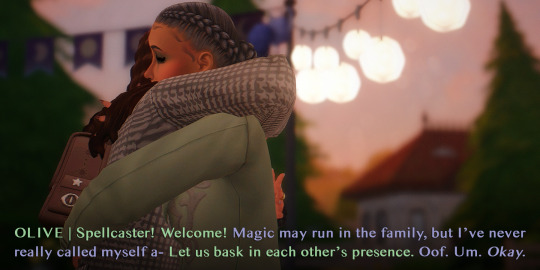


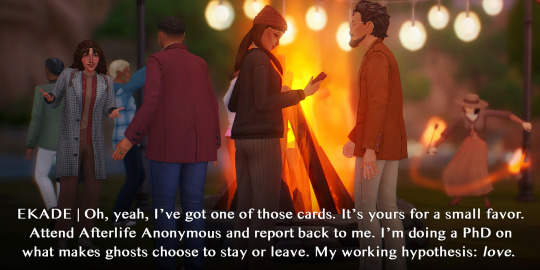




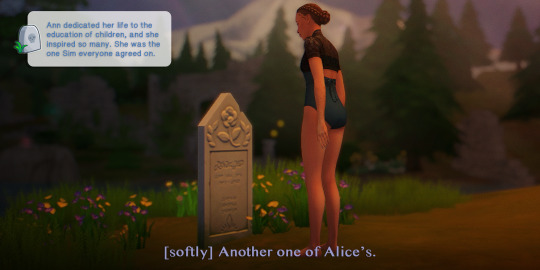

The Full Moon Revelry wasn't as rowdy as promised, but it was still illuminating.
Beginning / Previous / Next
You can read more about Naomi and Micah's grandmother's sacrifice (and their mother's quest to revive her) here!
Naomi: It's not too late to turn around. I can already tell this thing will be full of freaks and weirdos.
Micah: No one forced you to join me, you know.
Olive: Spellcaster! Welcome!
Micah: Magic may run in the family, but I've never really called myself a-
Olive: Let us bask in each other's presence.
Micah: Oof. Um. Okay.
Naomi: Awfully touchy-feely for a stranger.
Olive: Your grandmother always spoke so highly of you both.
Naomi: [snorts] Yeah, right.
Micah: Wait, you know Grandma?
Olive: The dead and the living of Ravenwood owe her a great deal. If the Magic Realm had fallen all those years ago, the Netherworld would have shortly followed.
Naomi: Right. She sacrificed herself for the good of all Simkind, blah, blah, blah. You know what else runs in our family? Tall tales. Now, who the fuck is this ugly hunk of granite?
Olive: Why, naturally, that’s the Ancestor!
-
Ekade: Oh, yeah, I’ve got one of those cards. It’s yours for a small favor. Attend Afterlife Anonymous and report back to me. I’m doing a PhD on what makes ghosts choose to stay or leave. My working hypothesis: love.
-
Naomi: Can we go yet? This crowd is fucking lame.
Micah: We have to stay for the swim, at least.
Naomi: Oh, right, the exhibitionist parade. Yippee.
-
Naomi: Hellooooo! I thought we were all getting naked.
God, it’s freezing in there. Someone could have died!
Olive: Indeed. It’s rather a shame no one did.
Naomi: Lady, what’s wrong with you?
-
Micah: [softly] Another one of Alice's.
-
Micah: Naomi, wait! There's something buried here!
#ts4#sims 4#ts4 gameplay#ts4 story#story: mourningvale#legacy: g9#micah uchiyama#naomi uchiyama#olive specter#my head canon to explain naomi's skeptic trait is that she doesn't really believe all the stories she's been told about her family's past#since she grew up in a pretty normal way and only ever saw magic used in practical applications#it's hard for her to fathom the more fantastical side of it#plus her mom writes spellcaster fiction which makes the lines a bit blurry#so she may be in the midst of a big wakeup call or several :)#what is olive's swimwear though lmao
124 notes
·
View notes
Text
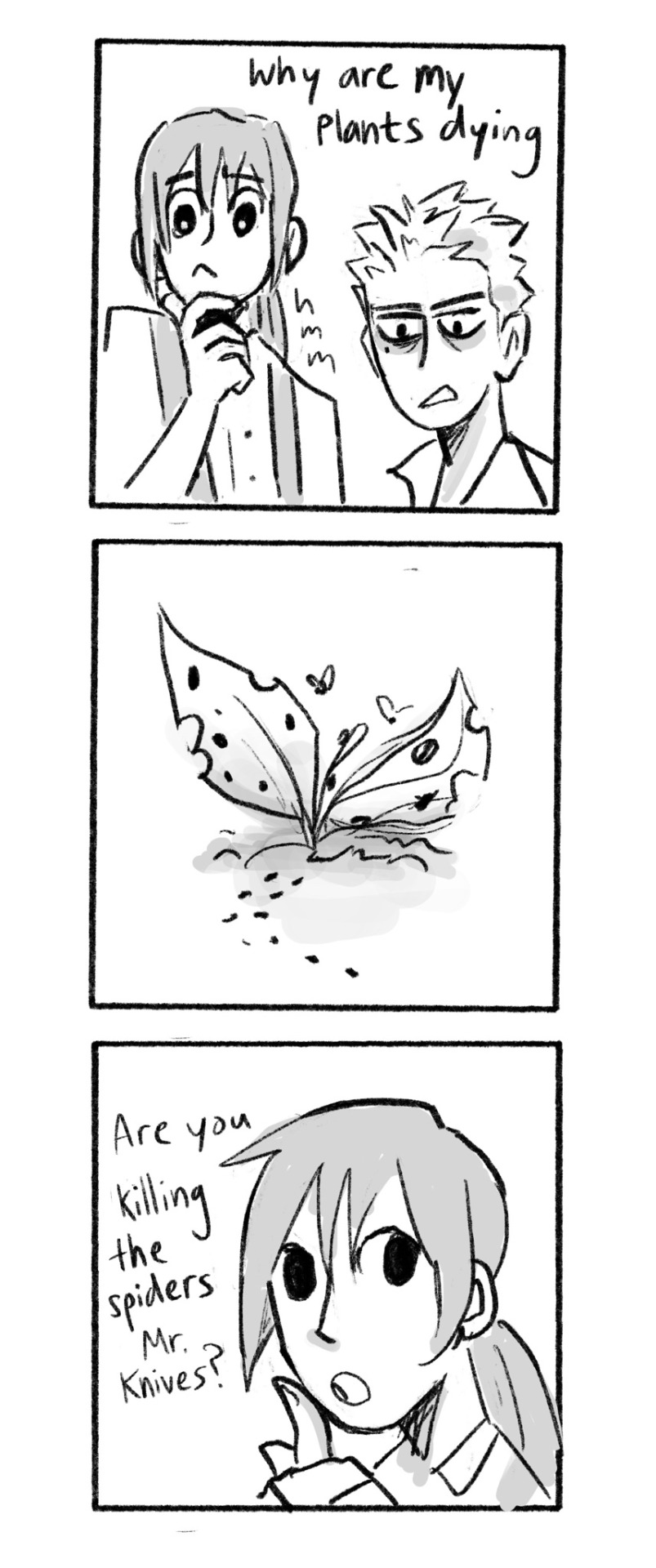

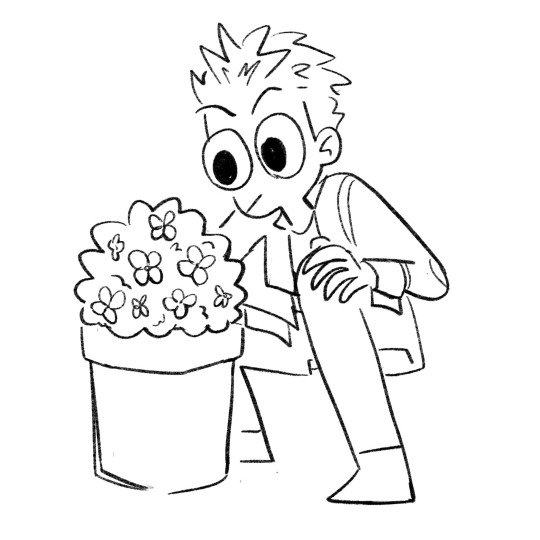
philosophical debates and fights to the death won't fix him but @carrionkid and I agree that gardening would
#teach this man basic ecology through practical application#trigun#trigun 98#trigun milly#milly thompson#millions knives#knives trigun#tristamp#trimax#my art
2K notes
·
View notes
Text
And the award in physiology or medicine already seemed to promise some practical application for these seemingly esoteric studies.
"Frankenstein's Footsteps: Science, Genetics and Popular Culture" - Jon Turney
#book quote#frankenstein's footsteps#jon turney#nonfiction#nobel prize#physiology#medicine#practical applications#esoteric
1 note
·
View note
Text
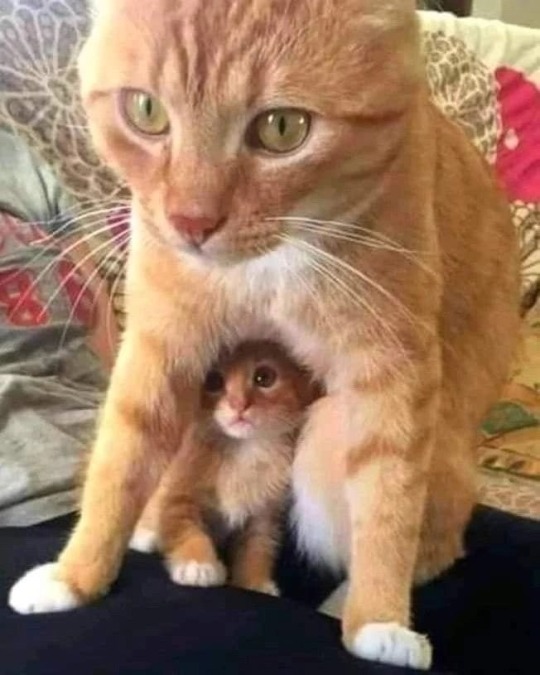
Leaked footage of Rayla defending her child against Aaravos in Arc 3
#She's on a quest to save her husband#Didn't trust anyone to protect their baby so she brought them along#No better way to learn martial arts than practical application#It's a learning experience#the dragon prince#tdp#greenlightarc3#continuethesaga#giveusthesaga#rayllum#tdp rayla#tdp speculation
68 notes
·
View notes
Text
How to Alter Your Perception for the Better
Control of negative thought patterns is necessary to prevent the development of fear, paranoia, or hatred. Perception is the key to understanding and interpreting the world around us. Learn how to alter your perception for a better outcome.
youtube
#how to alter your perception#personal growth#How to Altered Your Perception for the Better#perception psychology#negative thinking#SelfImprovement#MindsetShift#PositiveThinking#PersonalGrowth#ChangeYourMindset#PerceptionShift#PositiveChange#Mindfulness#InnerTransformation#SelfDevelopment#thoughts and behaviors#personal growth motivation#the elite power of perception#kaleidoscope#practical applications#thoughts and feelings#Youtube
0 notes
Note
One problem with Hindus (especially conservative ones) is that they support various gender expressions and identities as long as it's related to mythology
Like we see girls in drag cosplaying Krishna and that's widely accepted. They do drag for other mythological characters as well. We see men in drag in mythological theatrical productions but if a man is in drag that's NOT related to mythology, he'd get shamed. Same thing with men being and acting feminine (no doubt, positively in this case) as long as it's related to a mythological act, or scene. Graceful male traditional dancers for example, are fine. But if that same man dances "femininely" to a Western song, he gets called slurs.
And then the trans topic is an entirely different topic.
Ykwim?
Yeah, IKR?
Vishnu turns into Mohini to get the Amrit from the Asurs? A-OK
Lakshmi having feelings for Her Narayan even in that form? *Le gasp* Paap! Anuchit! Dandaniya!
Men acting/looking feminine? *Insert all the hu mofo bian insults you can think of*
Ardhanarishvar being partly both Male and Female at once, and hence neither as a whole? *BrIlLiAnCe Of SaNaTaN dHaRmA!! Rahhh!! InInIn!! 🦚🦚🦚*
Non-binary people? Intersex people? *ThEy ArE (r-slur) pEoPlE wItH bRaInRoT fRoM pRoPaGaNdA!!!*
Don't these people love yapping about their favourite scriptures? Don't they read them? Don't they know that Para Brahman (I'd have said Debi, but not everyone is open to accepting anything besides what they've stuffed in their craniums for so long, so generalising...) is in everything in this Universe?
I don't mean only humans, or even living beings. Every atom is supposed to hold Para Brahman, the same way They hold the Universe within Themself
#conservative hypocrisy#hindublr#desiblr#hinduism#our languages most likely don't have gender specific words to refer to someone anyway#you know how they say you can be gay and still be homophobic?#this is pretty much just like that#you can be a hindu and still be hinduphobic#corrupting our culture and traditions#shallow surface-level theoretical idea of our teachings but no practical application
96 notes
·
View notes